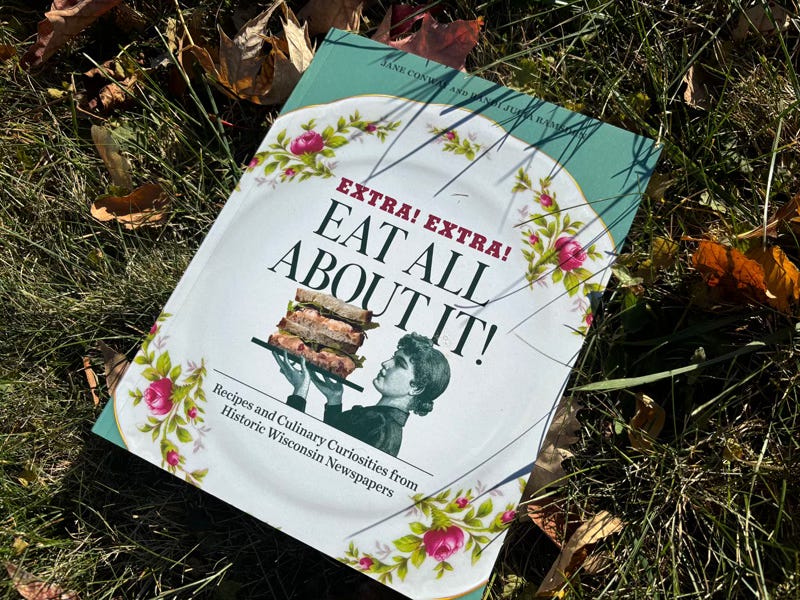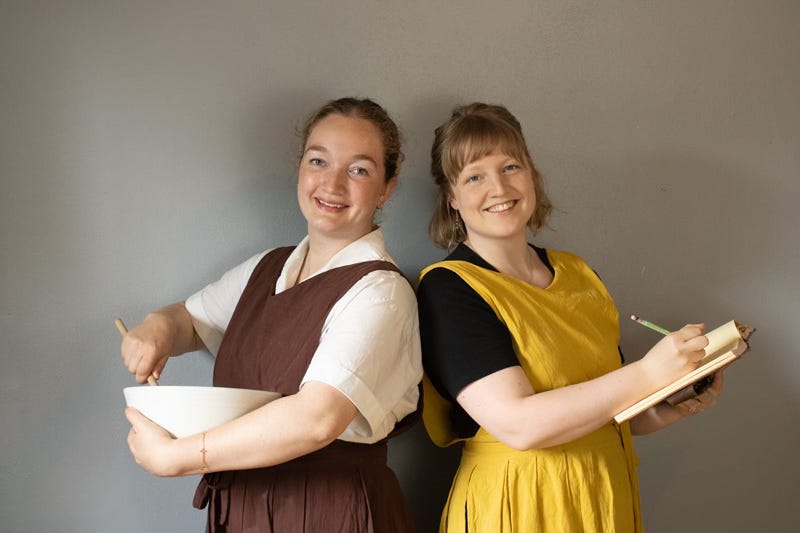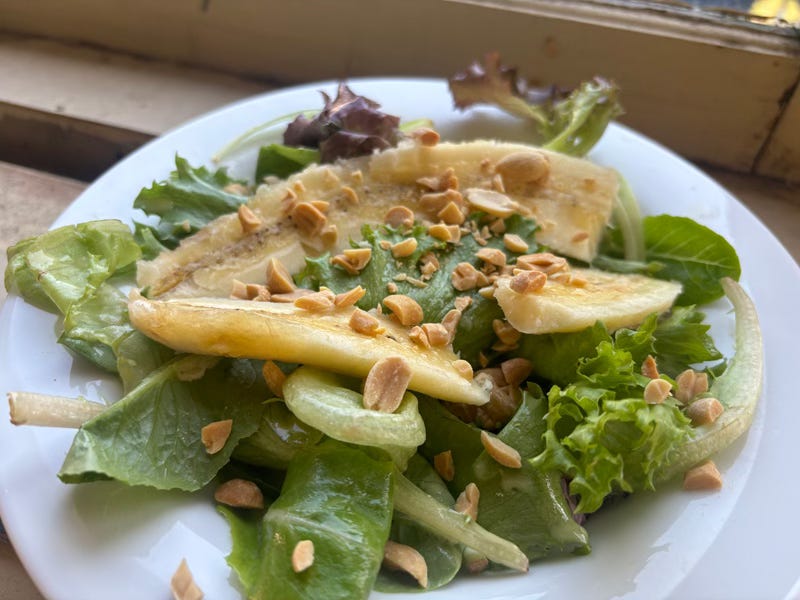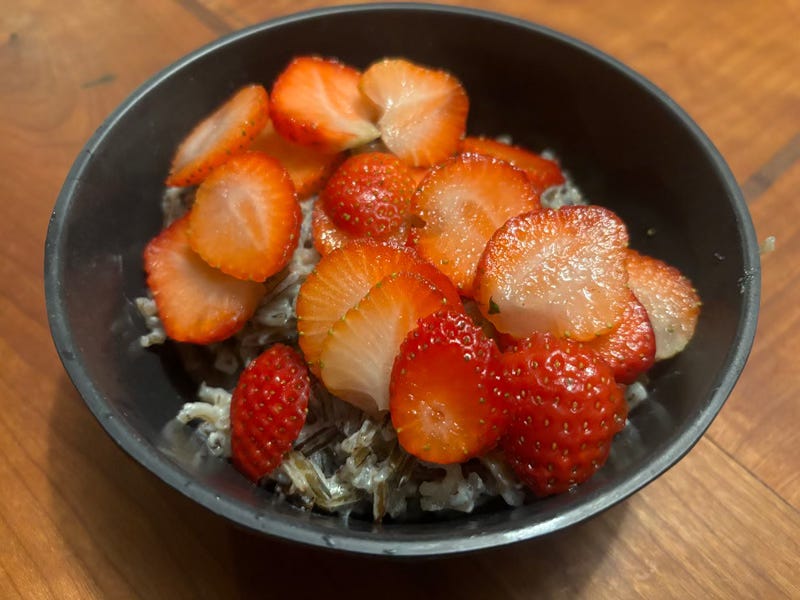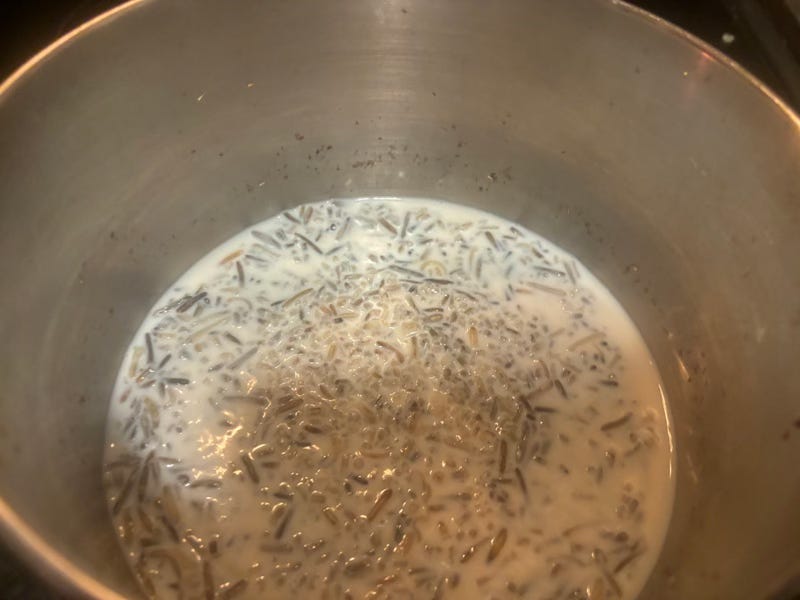THE COOKBOOK TEST #0059: EXTRA! EXTRA! EAT ALL ABOUT IT!
INSTALLMENT #0059 (FREE) ANOTHER COUNTRY / AN INTERVIEW WITH THE AUTHORS / BANANA SALAD?! / WILD ABOUT BREAKFAST
Dear Readers,
This week's subject is a book that sits squarely athwart four of my favorite points of interest: newspapers, history, Wisconsin, and food. EXTRA! EXTRA! EAT ALL ABOUT IT! RECIPES AND CULINARY CURIOSITIES FROM HISTORIC WISCONSIN NEWSPAPERS harks back to a bygone time where every community's independent newspaper was a river of commerce and public discourse, where you couldn't just hop on the Internet and grab any number of poorly edited recipes with 3,400-word wind up essays generated either by AI or writers who set the tone for AI, and where a good recipe was a treasured thing to be copied and recopied by hand, shared with descendents and made often if the ingredients were readily available at the local grocery store, or probably never if not.
Extra! Extra! is a collection of vintage recipes (generally from about 100 years ago, but some even older than that) harvested from the archives Wisconsin newspapers. These include everything from pimento sandwiches to mock pumpkin pie to cherry fritters - you could and possibly should create a full soup-to-nuts vintage American heartland meal using this book as a guide. Every recipe is introduced with a historical observation that helps situate the book firmly in an era before modern medicine, generally accessible electric power, and effective mass communication - it's a bit of a trip to consider how remarkably far humanity has come in just a handful of generations.
The book's core strength is dipping into the culinary past and unearthing insights into how people lived, cooked, and ate in Wisconsin 100 years ago. Ovens were largely woodfired and hard to control, so recipe times and temperatures were a far cry from the specific call out of minutes and degrees that we live and die by in the modern era. (Speaking of which: I recently watched my brother cook Pillsbury Orange Rolls inside of orange peels on a campfire, and that was a 100% "use the force" situation where observation and good judgement eventually brought us to delicious success at roughly triple the time listed on the tube.) Chapters on esoteric topics such as the spread of bananas across the country and the birth of instant hot cocoa mix make Extra! Extra! a genuinely engaging read - just about every chapter taught me something entertaining or intriguing that I'd legitimately never heard about before. The deadly nature of rhubarb leaves was particularly chilling, as I harvest piles of that stuff from the yard every spring.
At any rate: the book was a thoroughly enjoyable read, packed with culinary and cultural history. But how will the recipes prove out? Particularly bananas and mayonnaise in salad form?
at your service,
James
EXTRA! EXTRA! EAT ALL ABOUT IT! RECIPES AND CULINARY CURIOSITIES FROM HISTORIC WISCONSIN
JANE CONWAY AND RANDI JULIA RAMSDEN
WISCONSIN HISTORICAL SOCIETY PRESS | 2024 | $30
The authors of Extra! Extra! were drawn to their material through a long, punishing process of osmosis - they absorbed the contents of countless old newspapers while working at the Wisconsin Historical Society for the National Digital Newspaper Program. Ramsden and Conway logged long hours turning fragile paper into more preservable and shareable digital records, and the recipes of bygone eras really stood out.
"It was kind of like a game for us to find recipes and say: 'oh, this sounds really gross,' or 'this sounds really good,'" says co-author Jane Conway (below, left). "And eventually we started cooking together."
A Great Depression-era potluck including the likes of a spinach and onion jello salad and a butterscotch macaroni pudding kicked off the project. "As we tried them, there was a lot of conversation about tweaking the recipes," recalls Ramsden (above, right). "And that's when we got really intrigued. It was much more than taking old recipes and cooking them - there was so much interpretation that we had to do. And so we kept going."
One of the key challenges of cooking recipes from a century in the past was rediscovering sometimes simple tricks that would have been standard knowledge back in the day. "A lot of the recipes would include steps like: 'Finish with a simple white sauce,'" says Conway. "Well, OK, what does that mean? So we'd go back to the newspapers from the same time period to find recipes for plain simple white sauce to use for that."
Ovens were another significant challenge, recalls Ramsden. "People just knew their oven, so they knew what a 'quick oven' meant to them," she says. "Now we just set things to 350 degrees and let it preheat, and no matter what kitchen you're in you can rely on that."
"The amount of prep work needed to get your oven ready, particularly if it was a wood-burning stove - you had to start it so early to get the temperature to the right place, get the wood burning correctly... the whole endeavor was not nearly as simple as cooking is today," adds Conway.
Even the physical space was different, the authors note - everyone worked sitting down because every task took longer to do, and kitchens were built accordingly - big tables dominated the room, and modern-style countertops weren't generally to be seen. Conway adds that the lack of refrigerators near the start of the 20th Century means that home cooks would "...be running off to all different parts of their home or homestead or maybe heading out to the root cellar to grab vegetables, or down to the basement to grab preserves to bring to the kitchen."
As relatively primitive as cooking conditions might have been, Ramsden and Conway were surprised by the modernity of one aspect of vintage recipes: the ingredient lists, which often included surprisingly global commodities. "We found a recipe for coconut cake in 1888, and then the question became: 'How did we have coconuts here?' says Ramsden. "And they came either from the South Pacific through the West Coast, but those were mostly for coconut oil and soaps and butters and whatnot. And then from the Caribbean and South America and Central America, dried coconut goods would come through New Orleans. The Mississippi was right there so they'd be shipped up the river to Wisconsin. For other things like bananas and spices, you could get a lot more than we thought you could."
I put the authors on the spot and asked for favorite recipes. For Conway, it was the Swimming Island: "Just reading it I was kind of repulsed of the idea - a hard boiled egg rolled in cinnamon and sugar seemed wrong. And then deep frying it and eventually serving it with wine poured over didn't sound like it would work with the flavors, but then trying it actually was amazing. It was a really fun process to make and a really exciting dish to serve to others - it's a whole event."
For Ramsden, the sweet pickled peaches have stood the test of time. "I make those every year now in the summer, they're so delicious," she says. "The brine is apple cider vinegar and brown sugar and cinnamon and cloves, and it's just the perfect dessert for the holidays when it's cold out. And then you can use that brine ... we've mixed it with wine, or you can add it to an Old Fashioned, and get that little bit of spicy sweetness in there."
BANANA SALAD?!
My strength and weakness as a writer and reviewer is that whenever I see something on a menu or in a cookbook that seems jaw-droppingly stupid, I am compelled to interact with it. I know in my heart of hearts, the readers or viewers want me to do the stupid thing, and I am nothing more than a tool of the readers, so off I go.
In that spirit: when I noticed that Extra! Extra! was packing a recipe for banana salad (featuring peanuts, lettuce, bananas, and mayonaise), I sprang into action. First: I made the book's mayonaise recipe from scratch. (It was kinda watery - either I didn't incorporate everything aggressively enough or that's how mayo used to be. Either way: It worked well as a salad dressing in that state.) Then I sliced up bananas, chopped up peanuts, and dressed a pile of greens with the whole assemblage.
I stared at what I did. I felt weird about it. A little proud? But also a little afraid that someone might walk into the kitchen and demand answers that I couldn't possibly supply.
Also: Did you know that bananas are technically a berry? I did not. Thanks, Extra! Extra! for that weird little tidbit that I can use to bore my children during an otherwise slow and peaceful moment.
Ah, yes, back to the salad. It tasted - not GOOD, exactly, that's certainly not the word, but not wretched, nor confusing, nor horrifying. It was surprisingly light, much fresher than I expected, and a textural pleasure with the banana, lettuce, and peanuts all contributing their own particular points of view.
I'm not including the recipe here because I am never ever making this weird 108-year-old thing again, nor do I expect any of you to do so, but should you find yourself moved to dress lettuce with homemade mayo, chopped nuts, and bananas, you may find yourself with something far less demented than you expected.
WILD ABOUT BREAKFAST
Way the hell back when I landed in Minneapolis-Saint Paul, I was working for a reasonably well-known radio personality (then future senator, now former senator Al Franken) who was obsessed with the wild rice porridge at Hell's Kitchen, a strappy little independent breakfast spot in downtown Minneapolis. I tried it, and I dug it too. (Not as much as their homemade peanut butter spread on toast, but a fair bit.) Hell's Kitchen eventually became a strappy huge, employee-owned breakfast spot, and published a cookbook revealing the secrets of the porridge, but I never got around to making it.
Now, thanks to Extra! Extra!, I have accidentally backed into making something remarkably similar in my own kitchen. I was concerned that the cook time for the wild rice would be insufficient, but it worked out great. I felt strongly that this was a dish that deserved real maple syrup, so I added it. That also worked out great. All I had on hand were fresh strawberries, but those worked out great, too. This is a delicious breakfast and, I suspect, not entirely terrible for you, as well. I plan to make it a fixture of the breakfast table this winter.
BREAKFAST RICE
Via Extra! Extra! Eat All About It! from the Iron County News, March 14, 1914
1 cup water
1 3/4 cups milk
1 cup wild rice
Pinch salt
Pinch nutmeg
Splash cream if desired
2-3 Tbsp maple syrup if desired
Fresh fruit and/or nuts to top
Rinse rice. In medium pot, bring to low boil milk, water, rice and salt. Cover and simmer on medium until liquid has been absorbed, about 35-45 minutes for wild rice. To serve add nutmeg, cream, maple syrup, and/or fruit if desired.
EXTRA! EXTRA! EAT ALL ABOUT IT!
(***BUY IT / BORROW IT*** / SKIP IT / SCRAP IT)
Like many of the books I review around here, Extra! Extra! qualifies as "good enough to recommend" and "specialized enough to recommend with care." If a love for Wisconsin and/or history and/or newspapers and/or vintage cooking dwells within your heart, you'll find this eccentric and lovingly curated collection of old time recipes to be just what the editor in chief ordered. It's a culinary romp through history, packed to the rafters with small town memories and bygone flavors.


